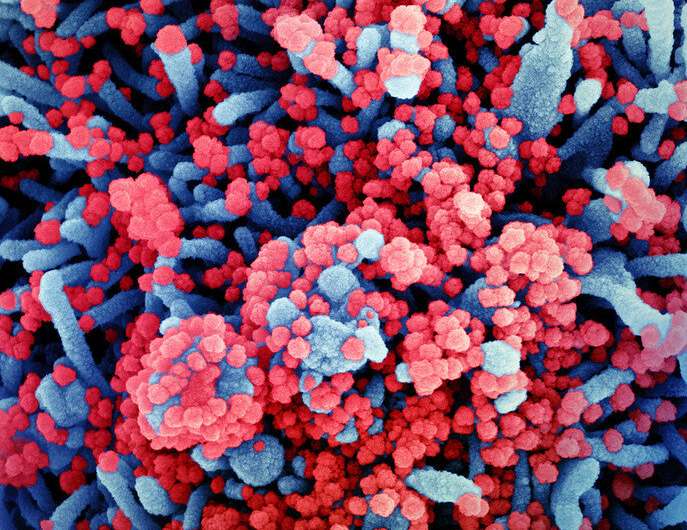Colorized scanning electron micrograph of a cell (blue) heavily infected with SARS-CoV-2 virus particles (red), isolated from a patient sample. Image captured at the NIAID Integrated Research Facility (IRF) in Fort Detrick, Maryland. Credit: NIAID
Vanderbilt University researcher Yi Ren is part of an international team that has confirmed the mechanism by which SARS-CoV-2, the scientific name for the strain of coronavirus causing COVID-19, targets and impacts its host factor protein. The article "SARS-CoV-2 Orf6 hijacks Nup98 to block STAT nuclear import and antagonize interferon signaling" was published in the journal Proceedings of the National Academy of Sciences on Oct. 23.
Ren, an assistant professor of biochemistry, studies the basic mechanism by which proteins are expressed within cells, and how different viruses target and hijack the function of critical immune factors within the cells' machinery.
Her expertise is in influenza A—the only influenza virus known to cause global flu disease epidemics—and vesicular stomatitis virus. VSV is a rabies-like virus that predominantly infects cattle, horses and pigs. The virus is highly sensitive to interferons, the signaling proteins that are made by host cells when they sense a virus. The interferons' purpose is to induce nearby cells to boost their anti-viral defenses.
Reviewing coronavirus-related research early in 2020, Ren came upon an article that suggested the SARS-CoV-2 protein had similar characteristics to VSV, in that it acts to tamp down the interferons that would otherwise kick off an immune response in the host. "From the literature review, I understood that I had the requisite specialist knowledge of how protein expression is blocked in VSV to meaningfully contribute to COVID-related research," Ren said.
Together with longtime collaborators at the University of Texas Southwestern Medical Center and the Icahn School of Medicine at Mount Sinai, "We were able to test the direct interaction between the host factor that I work with and the SARS-CoV-2 protein. We found that, indeed, they interact," Ren said.
The findings show that SARS-CoV-2 uses a similar strategy as VSV to target the same susceptible protein known as a host factor. The difference is that SARS-CoV-2 has a mechanism that stops proteins from sharing genetic information with the host cell nucleus. This blocking behavior enables suppression of the immune system. This mechanistic finding was a huge surprise for Ren, who has spent so much time in the lab with VSV.
"Even though SARS-CoV-2 is an entirely new virus that the world is grappling with, it deploys a similar strategy to target the same host factor as VSV, making me feel somewhat familiar with the virus. After so many years of studying influenza A and VSV, to see such a small difference on a cellular level resulting in what we've seen during this pandemic puts these 'small' differences into perspective," said Ren.
The lab continues to work on the structural characterization of the virus-host interaction so researchers can explore it further. Ren's team soon will be able to show how the virus protein targets the host machinery and its consequences on the atomic level, an essential step in designing therapeutics to enable an appropriate host immune response.
"We have a very strong community of structural biologists at Vanderbilt and amazing resources that we're all sharing," Ren said. "As everyone is seeking to contribute to COVID-based research, my lab quickly shifted our attention and are working hard to push our understanding of this virus forward every day."
More information: Lisa Miorin et al. SARS-CoV-2 Orf6 hijacks Nup98 to block STAT nuclear import and antagonize interferon signaling, Proceedings of the National Academy of Sciences (2020). DOI: 10.1073/pnas.2016650117
Journal information: Proceedings of the National Academy of Sciences
Provided by Vanderbilt University
























